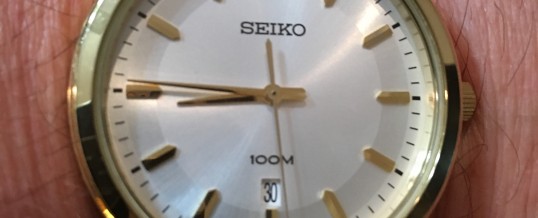
Watches are going the way of the buggy whip.
Many people, especially younger folks, are opting out of wearing a wristwatch. It seems that the same thing that made the Kodak camera, the video camera, the calculator, and many other once commonplace items, has also made the watch obsolete. The smartphone.
As if people needed another reason to stare at their cellphone, the iPhone is also now a timepiece for many.
Long before batteries powered watches, you had to wind your watch each day. This meant that the internal works of each piece had to be well-built to keep good time. That came with a price. Fifty years ago, a nice watch could cost what today would be the equivalent of several hundred dollars. Today, a very accurate watch can be had for a few dollars.
When I was a kid in the 60’s, to be given a watch was a very big deal. Quality watches were expensive, but older, used watches were affordable.
My dad gave me my first watch. It was a cheap one. You don’t give an eight-year-old an expensive watch. It was what was called a dollar pocket watch. They were sold in hardware stores for a buck.
It had a silver metal case, a black dial, and the numbers were painted with radium. Radium is a natural element that, when painted on the dial, makes the numbers on your watch glow in the dark. Which was great, except that too much exposure to radium also makes you glow in the dark.
They stopped using radium on watches by the early 60s.
I can remember sitting in Mrs. Morris third grad class admiring my watch. I was so engrossed in my new timepiece that I was unaware that she was suddenly standing next to me.
“That’s a very nice watch Johnny, but it looks like it’s time for you to put it back in your pocket and do your assignment,” she said.
Mrs. Morris’ play on words was lost on me.
Most blue jeans made today still accommodate a pocket watch. Inside the front right pocket on a pair of jeans is a smaller pocket. It’s called “The Watch Pocket.” Few people give it a second thought and even fewer put anything in it. But, 100 years ago, that’s where men kept their watches.
Pocket watches were prominent in America until the early part of the 20th Century. Europeans began wearing watches on their wrist, many of them soldiers during World War I. Being able to quickly get the time and synchronize what you and your partners were doing in a war was a decided advantage.
Many American movie actors were the impetus for those in the U.S. to transition from pocket watches to wristwatches. Hollywood stars wore them in their films. Today, actors and sports figures are still paid big bucks to wear a company’s wristwatch. But, that no longer seems to have much impact with the younger generation.
Except for the Apple Watch, there hasn’t been much in the way of new and innovative wristwatch technology. From what I can see, the Apple Watch hasn’t really caught on.
I still wear a wristwatch. It’s a gold-colored Seiko with a large analog dial, the date, and a second hand. I also have a pocket watch that belonged to my great grandfather.
I hate to see portable timepieces fading away. If you need to signal someone that it’s time for you to go, whipping out your iPhone doesn’t even come close to having the same, subtle message as looking at your Seiko.
Elsewhere, the wristwatch may take a licking, but at my house, it’ll keep on ticking.
©2016 John Moore
To read additional blogs, visit johnmoore.net/blog
MAY
2016
